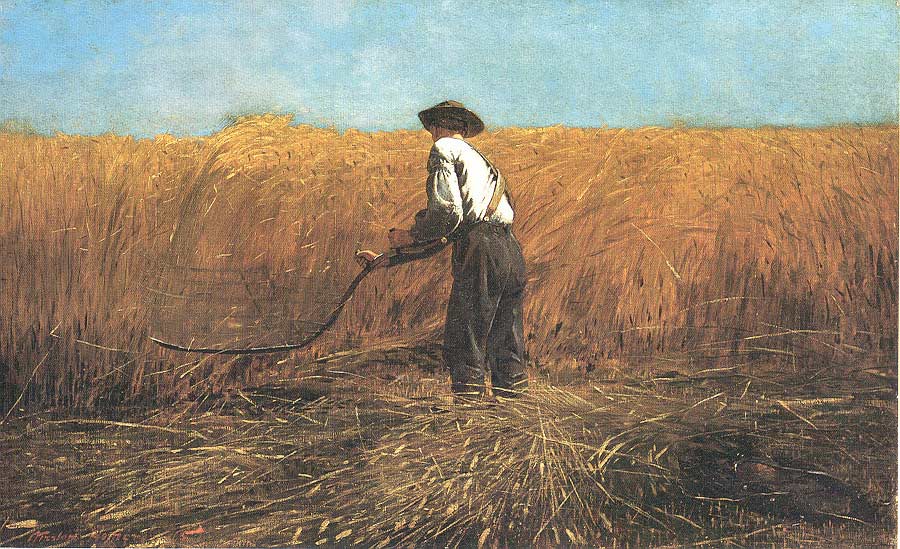|
Commentary : |
Completed in 1865, the
year that the Civil War ended, this work was offered for sale at the
sixth annual exhibition of the Artist's Fund Society in New York that
same year. After this exhibition, where the picture was poorly
received, Homer changed various elements and offered it at auction in
1866. The site depicted is a farm in Belmont, Massachusetts, and the
anonymous figure has been said to represent the reunion of man and
nature after the war. Homer's solitary harvester is identified by the
cloverleaf insignia on his canteen as a Northerner who fought with the
First Division of the Second Corps of the Sixty-first New York
Volunteers. The painting was engraved for Harper's Weekly on July 6, 1872.
is one of his most famous paintings.
Extraordinary work because WH had only been painting for 5 years
and exhibiting for 2. Dramatic change in topic and style from
early propaganda illustrations for Harper's.
3 parts: veteran with scythe seen from behind and placed in centre
of painting with army jacket and canteen in lower right-hand
corner, earth and field of wheat, band of sky. Painted 4-5 months
after surrender at Appomattox 9 April 1865 and captures his thoughts
about significance of Confed surrender and end of the war.
Symbolic references to:
- Roman leader Cincinnatus who left farm to assume dictatorship
of Rome, defend it against enemies, relinquished political office
and dictatorial power to return to farm to peaceful occupations.
Veteran American Cincinnatus model republcian soldier.
- Biblical reference to Isaiah 2:4 "And they shall beat
their swords into ploughshares, and their spears into pruning
hooks; nations shall not lift up sword against nation, neither
shall they learn war any more." Need to heal torn nation
after bitter 4 year conflict
Celebration of end of the war:
- bounty of harvests during war, US still largely agricultural
nation, dependent upon harvests during war for supplies, no poor
harvest during war years, avoided hardship for both civilians
and military (1.5 million in army). Harvest of 1865 was especially
good
Darker meaning of the scythe:
- WH deliberatley chose incorrect agricultural implement (single-blade
scythe instead of cradled scythe) in order to make reference
to Death as grim reaper. Veteran once harvester of men. Compare
OH O'Sullivan's photo of the "Harvest of Death" at
Gettysburg.
Political meaning of the veteran who willingly demobilises
and returns to civilian life after war service. Strength of American
democracy and republican system. Problem of demobilising New
Model Army, backpay, indemnity for loss of life and property.
If army refused to demobilise danger of US becoming a European-style
military dictatorship. Social problems of traumatised veterans
seem to have been avoided.
Mourning and grieving for assassination of Abraham Lincoln 15
April 1865. Cut down by assassin. Elegy upon the death of Lincoln:
simplicxity, solemnity, wheat sheaves used to decorate coffins
|
|
